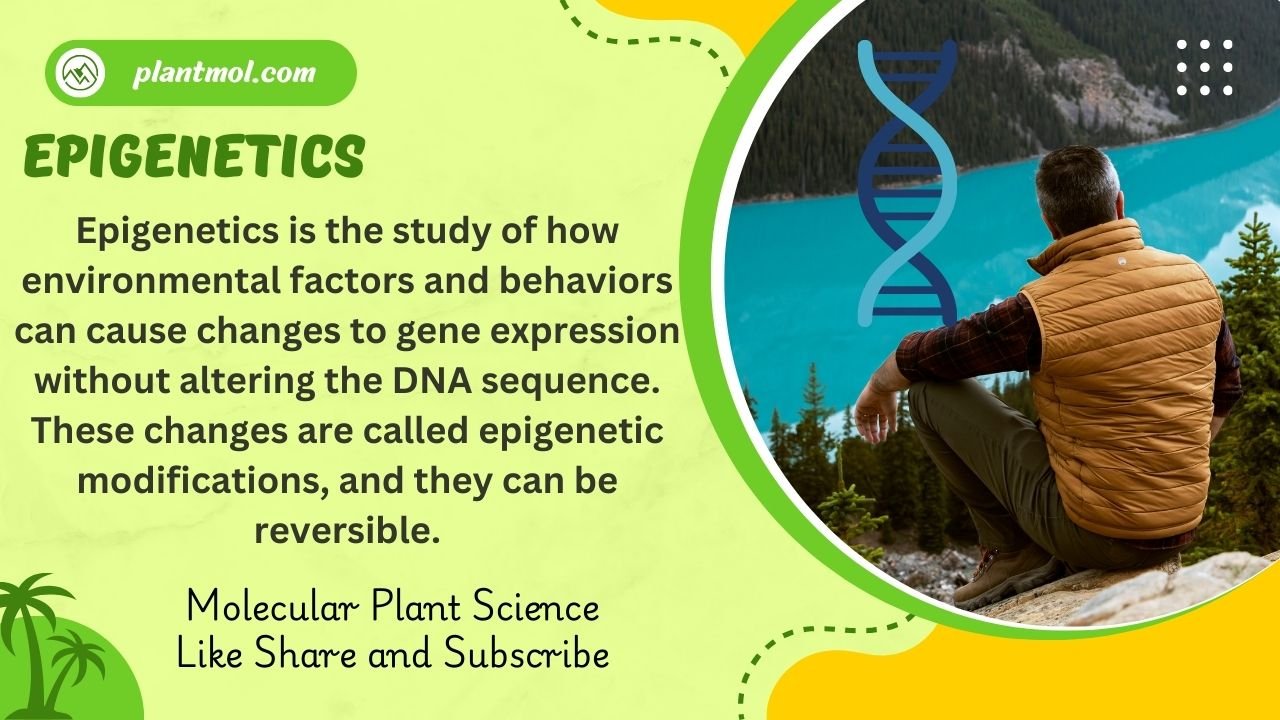Introduction to Epigenetics
Epigenetics is a branch of molecular biology that studies how environmental factor and stimulus regulate the expression of the gene without altering the underlying DNA sequence. These changes are called epigenetic modifications, and they can be reversible. These modifications often occur in the form of methylation or histone modification, which can change the accessibility of DNA to the transcriptional machinery, thereby affecting whether a gene is turned on or off.
One of the fundamental concepts in epigenetics is the idea that gene expression is not a static process. Rather, it is highly responsive to both internal cellular conditions and external environmental stimuli, such as temperature, light, and nutrient availability. This responsiveness allows for a level of flexibility in gene regulation that is essential for the growth and adaptation of organisms, particularly in plants, which are constantly interacting with their environment.
Epigenetic mechanisms are critical for various developmental processes, including cellular differentiation, maintaining stem cell pluripotency, and regulating responses to environmental stressors. By acting as a regulatory layer above the genetic code, these mechanisms ensure that genes are expressed at the right time and in the appropriate cell types. This level of regulation is vital for enabling plants to adapt to changing conditions, ensuring survival and reproductive success.
This foundational understanding of epigenetics lays the groundwork for exploring its applications in plant biology, including how epigenetic tools can be harnessed for improving crop yields, developing disease resistance, and enhancing stress responses. As the field of epigenetics continues to evolve, its implications for agriculture and environmental sustainability become increasingly significant.
Mechanisms of Epigenetic Regulation in Plants
Epigenetic regulation in plants is a complex and multifaceted process involving several key mechanisms that influence gene expression without altering the underlying DNA sequence. The primary mechanisms include DNA methylation, histone modification, and RNA-associated silencing. Each of these plays a significant role in determining how genes are expressed in response to both internal and external stimuli.
DNA methylation is one of the most well-studied epigenetic mechanisms. It involves the addition of a methyl group to the cytosine bases in DNA, typically within CpG dinucleotides. This modification can lead to the repression of gene expression by preventing the binding of transcription factors. In plants, the role of DNA methylation is crucial for processes such as developmental regulation, transposon silencing, and responses to environmental stresses. Changes in DNA methylation patterns can be heritable, thus allowing plants to adapt to changing conditions.
Another vital mechanism of epigenetic regulation is histone modification. Histones are proteins around which DNA is wrapped, and their chemical modifications can either promote or inhibit gene expression. Common modifications include acetylation, methylation, phosphorylation, and ubiquitination. The balance of these modifications determines the accessibility of the DNA for transcription. In plants, histone acetylation generally correlates with active transcription, while methylation may be associated with transcriptional repression. These modifications are dynamic and can be influenced by various environmental factors, highlighting the plasticity of epigenetic regulation.
Lastly, RNA-associated silencing mechanisms, such as RNA interference (RNAi), play a pivotal role in gene regulation in plants. Small interfering RNAs (siRNAs) and microRNAs (miRNAs) can target mRNA for degradation or inhibit its translation, effectively downregulating specific genes. This form of regulation is integral for controlling gene expression during developmental processes and in response to environmental cues. Additionally, these RNA-based mechanisms can lead to changes in DNA methylation and histone modification, further intertwining the various epigenetic systems at play in plants.
The Role of Epigenetics in Plant Development and Adaptation
Epigenetics plays a significant role in the complex mechanisms by which plants regulate gene expression, impacting their development and adaptation to varying environmental conditions. Unlike genetic mutations, which alter the DNA sequence, epigenetic modifications such as DNA methylation, histone modification, and RNA-based mechanisms modify gene activity without changing the underlying genetic code. These adjustments enable plants to fine-tune their growth patterns and physiological responses in real-time, effectively making epigenetics a crucial factor for survival and adaptability.
One prominent example of epigenetic influence is seen in the model organism Arabidopsis thaliana, a small flowering plant often used in research. Studies have indicated that Arabidopsis can exhibit differential expression of stress-responsive genes based on epigenetic marks. In response to drought stress, specific transcription factors may become activated via epigenetic remodeling, allowing the plants to conserve water and initiate adaptive responses. This adaptability is vital in environments where water availability fluctuates dramatically.
Another illustrative case can be observed in certain species of wheat. Research has demonstrated that epigenetic changes can enhance resistance to diseases and improve yield stability. For instance, wheat cultivars subjected to specific environmental stresses exhibit heritable epigenetic changes that lead to enhanced yield under adverse conditions. Such findings underscore the potential of harnessing epigenetic mechanisms for improving crop resilience, thus ensuring food security in the face of climate change.
The adaptive potential of epigenetics is also evident in trees such as Populus, which have demonstrated variable responses to temperature fluctuations and other seasonal changes. These adaptations are largely governed by epigenetic changes that facilitate quick responses to environmental shifts, ensuring longevity and health in diverse habitats. As such, understanding the role of epigenetics in plant biology paves the way for innovative approaches in agriculture and conservation, bridging the gap between environmental challenges and plant resilience.
Understanding the Central Dogma of Molecular Biology: From Stimulus to Gene Expression
Applications of Epigenetics in Agriculture and Horticulture
Epigenetics has emerged as a significant field of study with transformative potential in agriculture and horticulture. The understanding of epigenetic mechanisms offers new strategies to enhance crop resilience, optimize growth conditions, and improve yield efficiency. One of the primary applications of epigenetics lies in the development of more resilient crops that can withstand environmental stressors such as drought, salinity, and pest attacks. By manipulating epigenetic markers, researchers can induce desirable traits within plant species, thereby equipping them to better cope with changing climates and adverse conditions.
Moreover, epigenetic modifications play a critical role in nutrient utilization and growth rate. Tailoring epigenetic profiles can lead to improved nutrient uptake and utilization, which not only aids crop growth but also potentially reduces the need for chemical fertilizers. For instance, plants can be engineered to enhance their ability to access soil nutrients more efficiently through epigenetic mechanisms. This can significantly promote sustainable agricultural practices and minimize environmental impacts.
Future research directions in epigenetics involve integrating genomic and epigenomic data to create comprehensive models that predict plant behavior under various conditions. This approach can lead to innovations in breeding programs where epigenetic information is used alongside traditional genetic techniques to produce superior cultivars. Furthermore, advances in gene editing technologies, such as CRISPR, can be combined with epigenetic modifications, allowing for precise control over gene expression without altering the underlying DNA sequence.
In conclusion, the applications of epigenetics in agriculture and horticulture signify a paradigm shift in how crops are developed and managed. As research in this area continues to advance, it holds promise not only for increasing agricultural productivity but also for promoting sustainable and resilient farming practices globally.






An Introduction To Biotechnology: Key Concepts And Tools
[…] https://plantmol.com/understanding-epigenetics-the-key-to-gene-expression-regulation-in-plants/ […]